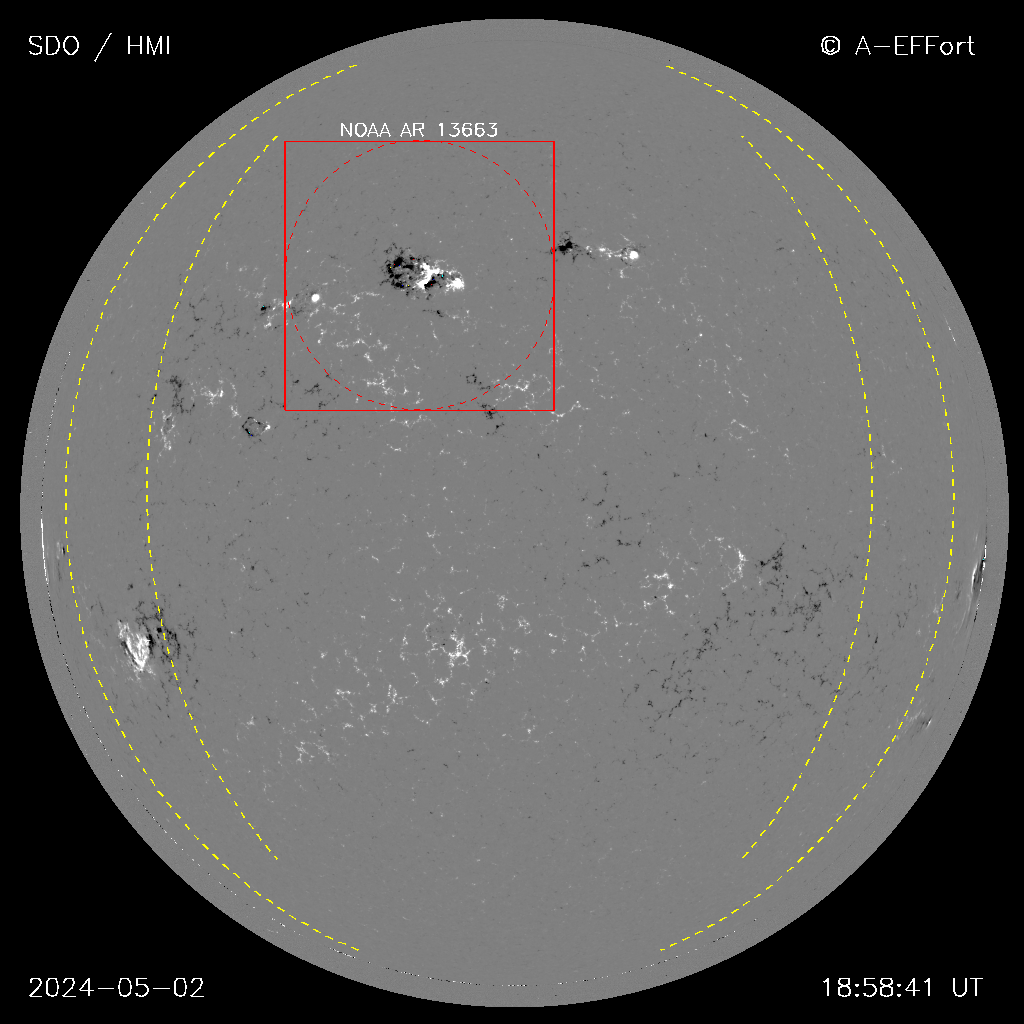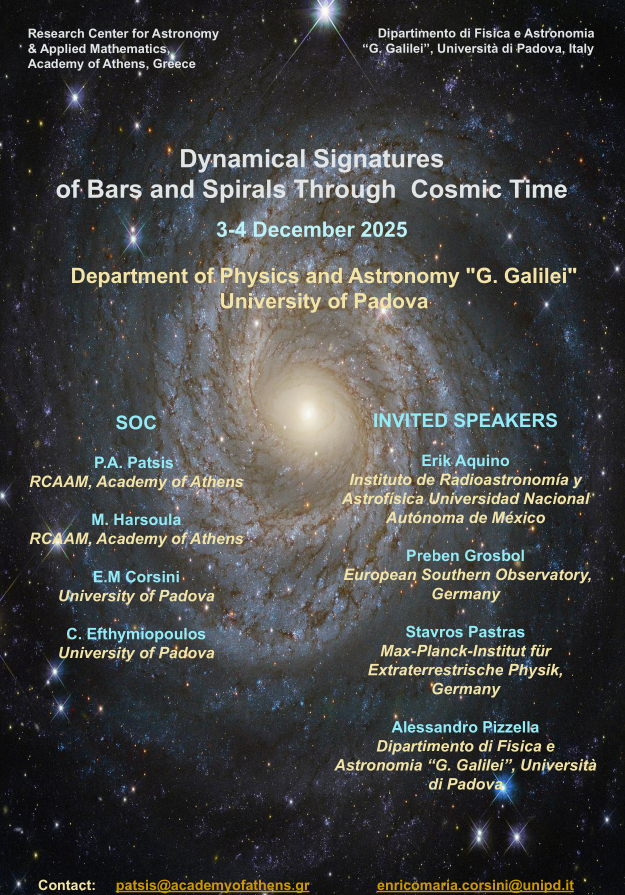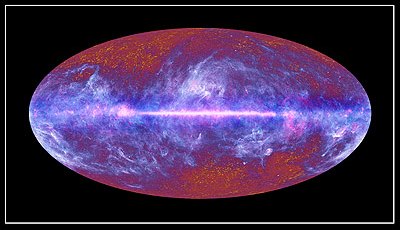Research
- Galactic Dynamics & Galactic Morphology
- Nonlinear & Chaotic Dynamics
- Solar Physics
- Cosmology and Gravity
- Magnetohydrodynamics
A detailed list of our research programs is available here.
Galactic Dynamics & Galactic Morphology
Galactic Dynamics is the tool to understand the observed Morphology of elliptical and disk galaxies. Our research combines Orbital Theory, N-body simulations and Hydrodynamics with Observations in large telescopes. The orbital analysis of bars and spirals in 2D and 3D models has revealed the dynamical phenomena that shape the forms of elliptical galactic systems, the spirals of normal and barred-spiral galaxies, as well as the edge-on profiles of galactic disks. In the last years research in this field in our institute has indicated the role of chaotic orbits in reinforcing the spiral structure in barred-spiral systems and in the dynamics of disk galaxies in general.
Nonlinear & Chaotic Dynamics
The research that is carried out in Nonlinear and Chaotic Dynamics has as goal the investigation in depth of chaotic phenomena and the application of Chaos theory in solving astronomical problems as well as problems in dynamics that are encountered in other science disciplines. The term "Chaos" means that the laws of Physics allow limited predictability, despite the fact that these laws are expressed by rigorous mathematical equations. Although the Theory of Chaos was first applied in astronomical dynamical systems, today it finds applications to various phenomena of interest for the everyday life (for example: earth and space weather forecasting, earthquakes, development of complex digital networks etc.).
In our Research Center Nonlinear and Chaotic Dynamics is used in Galactic Dynamics, Celestial Mechanics, Quantum Mechanics and Cosmology.
Solar Physics
The solar physicists at RCAAM possess significant expertise in the study and analysis of (1) magnetic loops in the solar corona, (2) particle acceleration processes in reconnection topologies, (3) small-scale eruptive phenomena in the solar atmosphere, such as coronal jets and microflares, (4) solar magnetography, (5) solar eruptions and the Sun-Earth connection, and (6) fundamental properties and complexity of solar magnetism. RCAAM solar physicists perform both data analysis and modeling, routinely analyzing data from multiple ground- and space-based instruments and actively collaborating with fellow astrophysicists elsewhere.
RCAAM solar physicists are active members of multiple international professional organizations and routinely attend and contribute to international Conferences, Workshops, and Symposia. They interact and collaborate with colleagues in Greece, Europe, the United States, and Asia (China, Japan). Some of these colleagues are, at times, invited to visit RCAAM and offer seminars and lectures. RCAAM is a member institution of the NASA Solar Dynamics Observatory (SDO) Feature Finding Team (FFT) Consortium, an international conglomeration of universities and research centers that will provide advanced tools of automatic, real-time solar data analysis to NASA's Heliophysics Event Knowledgebase (HEK). Furthermore, RCAAM solar physicists are co-Investigators in the design of the ASPIICS coronagraph of ESA's PROBA-3 mission. RCAAM is currently co-organizing the 13th European Solar Physics Meeting that will take place in Rhodes, Greece, in September 2011.
Cosmology & Gravitation
In the field of Cosmology, research ranges from observational to fully theoretical aspects of Cosmological physics. In particular we are interested in: (a) statistical properties of the large scale structures as well as the geometry and topology of the distribution of matter in the Universe, (b) constraints on the cosmological parameters from cosmological data, (c) evolution of perturbations and structure formation in different cosmological models, (d) the nature of dark energy and the possible interaction between dark matter and dark energy, (e) alternative theories (except dark energy) for the accelerated expansion of the universe, and (f) classical and quantum cosmology of scalar fields.
In the field of Gravitation, research is pursued in the following thematic areas: (a) classical problems in General Relativity, (b) alternative theories of gravity, (c) black hole physics and in particular the computation of Hawking radiation, black hole entropy and the possible solutions of the Black Hole Information Paradox, (d) quantum fields in curved spacetime, and (e) quantum gravity phenomenology.
Magnetohydrodynamics
The discipline of MagnetoHydroDynamics (MHD) studies the dynamics of electrically conducting fluids such as astrophysical plasmas. Over the years, we have developed pioneering semi-analytical solutions of the non-linear equations of MHD in non-relativistic protostellar jets, relativistic galactic and extragalactic jets, magnetized protostellar collapse, and the axisymmetric pulsar magnetosphere. We are currently studying accretion disk winds as “warm absorbers” in Active Galactic Nuclei (AGN). More recently, we have been working on a particular regime of MHD, namely Force-Free Electrodynamics (FFE), and developed our own numerical FFE code in the study of the three dimensional pulsar magnetosphere and the solar corona. We are currently investigating the origin of high energy radiation in the pulsar magnetosphere. We are also investigating the Poynting-Robertson Cosmic Battery, a novel astrophysical mechanism that we proposed as the source of magnetic fields in the Universe, and presented strong confirmation in radio observations of extragalactic AGN jets. We have active collaborations with NASA/Godard (USA), Cork University (Ireland), and Tsinghua University (China).





